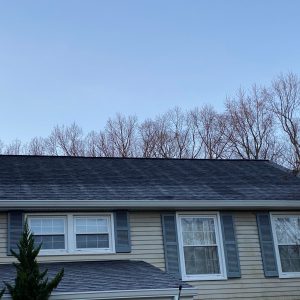Will this cause ice dams? 2nd floor roof question
I had a new roof installed so there is ice and water shield down under the first few feet of roof.
On the 2nd floor roof/attic I tore out all the old insulation, installed can lights and fixed a bunch of electrical, then installed poly-iso baffles that I’ve seen them suggest on this website, now I am installing R15 mineral wool batts in the joists and installing R30 mineral wool batts perpendicular. I came home and was looking at frost on the roof to see if the insulation was holding up. I can definitely see (on the 2nd floor roof) where I installed the baffles and the thermal bridging of the framing. Is this going to cause an ice dam though? I could imagine the melted snow on the upper portion of the roof would dam up behind the snow on the cooler lower portion above the baffle. I’m guessing the soffit and the insulated baffle of poly-iso is keeping the sheathing cooler and once it gets past that – the cooler air isn’t forced up the sheathing as much. Will I regret doing these baffles if we get some snow?




















Replies
Were these sealed cans? And is there another possible source of heat loss into the attic? (Bath vent, attic hatch/stairs). And sun hasn’t hit this side yet? You mentioned noticing it when you came home (late afternoon?)
Yes sealed cans - they are IC rated too so I can cover them with insulation. Morning sun has not hit this side of the roof yet. I still have a lot of R30 to lay - so I understand that I'm still losing heat, but my point is with the poly iso baffle - I will never have the same insulation rating on the portion of the baffle vs the rest of the roof - now that might not be a huge deal because poly-iso is like R3 or R6, but if ice/snow melts on the upper portion - I could definitely see it damming up where the poly iso is insulating. So even assuming that the entire attic is insulated - the R value of the baffle part of the roof is always more insulated than the rest of the roof. That is my question - isn't that going to cause an ice dam? If it does - I would much rather just run these baffles all the way to the ridge vent to prevent the damming.
Whelp, I’m in NW Ohio. I have 2’ overhangs. There are 2 runs of ice and water shield, so 6 ft up the roof edge. We live in the woods (locust and walnut) so no gutters. I think what you are seeing now without your job complete is no reason to be concerned yet. But, if you want to go right ahead. However, remember you are wanting to vent that attic space. The purpose of the baffles are so you don’t close off the intake with insulation. I don’t think it’s meant to keep it in a channel to its exit.
Here I don’t show the drastic frost/no frost as your picture. I’d be betting if your attic is sealed from heat loss, once done insulating you won’t see this drastic difference
Is there no insulation directly below that bare spot that stands out on the right?
Snow does melt on the roof and does go downhill. At the eave you probably will get some freeze, but nowhere near what you would get with a poorly insulated ceiling and no venting.
And sorry, just a dumb retired carpenter. There’s got to be somebody that studies this topic and with luck they’ll come here and relay it.
Best of luck!
Ice dams typically form when there is lot of snow on the roof (like 1 ft+) and the outside air is pretty cold. The snow acts like an insulating blanket and water forms on it's underside and runs down until there is no source of heat, where it freezes, causing the dam. If this is going to happen to you the water will freeze when it hits your overhang. I don't think the baffles are a factor at all. They might move the dam a bit farther up slope but that's all.
Note that over your rafters you have MORE frost so they're not thermally bridging they're actually insulating or perhaps just slower to warm up due to thermal mass. This is very common.
When temperatures are near freezing I see this sort of roof pattern all the time. It only takes a bit of extra heat to melt the frost first between the rafters, and most of these roofs are not going to grow ice dams.
If a lot of heat is getting into your attic (which we can't say yet) it is more likely coming from air leakage than poor thermal insulation. Often there is a direct pathway to the attic around plumbing vents or chimneys. Any 'bump up' framing features or skylights expose a lot of framing in the attic which may not be sealed. Bathroom vent fans sometimes blow right into the attic or the duct opening is hacked out without any sealing.
Batt insulation alone doesn't stop air very well, if there are openings to the heated space.
I would recommend hunting down air leaks and then just wait and see. Unless you get a lot of snow and you have pretty severe heat loss, you probably won't have ice dams.
cheers
Ian (from Ontario, Canada)